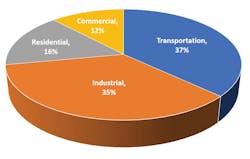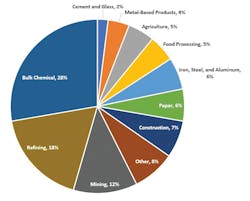How to reduce energy waste in the manufacturing sector
Energy efficiency is top of mind for many manufacturers who are working to develop sustainable practices. Those who pursue energy cost reduction as part of those initiatives not only position their company for better margins, they promote a high-growth, low-inflation economy. And when it comes to energy waste, there is plenty of room for improvement.
Industry uses more than one-third of all energy consumed in the United States, and when product transportation is factored in, the number is even greater. According to a report released in 2013 by Energy Central, the U.S. has taken over the top spot for energy waste. The report goes on to say that the U.S. wastes more energy than it uses effectively — a total of 58% of its energy is wasted.1 In a 2017 report, the New York Times states that America had increased that energy waste to 66%2 — not the worst offender this time, but still close to the top.
Getting a handle on energy management remains a broad undertaking for manufacturers. In an industrial setting, energy is used for production, building services, computing and administrative purposes. When it comes to machine and process energy waste, understanding the nature of energy waste, what the most common offenders are and what can be done to reduce it are key to taking control of energy waste.
Common causes of electrical energy waste
Improving energy management equates to responsible stewardship of natural resources and taking a full account of the interest of society and future generations. Wasting energy today is using resources that belong to future generations.
But many people have a mindset that wasted energy in production processes is a harmless — and perhaps unavoidable — byproduct of manufacturing. For instance, an employee may decide or be instructed to keep a motor running even if the actual need for its power in the system is intermittent. If the motors are small, an employee or business owner may think the motors don’t use a lot of electricity. But even small motors running idle draw electricity, and this wasted energy adds up over time.
For example, generally a small motor between 0.5-5 hp will draw about 1,500 watts/hour. A single 2 hp motor running for one day will use 36,000 watts (3.6 kilowatts) of energy. Keeping in mind there are roughly 300,000 factories in the U.S., the total number of motors that could be running idle across the country is pause for consideration.
Another example is found in the pharmaceutical industry, where energy waste is the largest among all industrial sectors. As patient medications have become more personalized, specific “million-bottle runs” are a thing of the past and so-called micro runs are now common. Operators stop these lines often to make adjustments, such as the number of tablets or a change in dosages. During that time lights are on, but the line is not
producing.3
As the pharmaceutical industry illustrates, the key offenders of energy waste are the principal operations that run for periods of time without cause. In addition, conveyor motors, blowers, pumps, vessel agitation and blending are a few examples of equipment and processes that are left on for extended lengths of time even when product or materials are not being run. For instance, in processes where a conveyor takes aborted material away, the conveyor will typically run for hours — if not days — without transporting any material.
How to take control of energy waste
To reduce wasted energy, you should start with the basics. Don’t try to fix everything at once. That approach will lead to failure and reverting to the logic that it is just easier to leave it alone. Find a simple energy waster and its most simple problem.
In the example of the conveyor that is left to run for hours even when it isn’t transporting material, this energy waste could be reduced through programming and a sensor. In this scenario, the conveyor can be paused when production is not in active operation. However, once the material comes within range of the sensor, the conveyor can run for a period of time and then cease once the material has cleared the sensor. This allows the conveyor to transport the aborted material to its destination and pause again until more material is available and ready for transport.
After basic energy wasting solutions have been applied, you can address other efficiency factors, such as:
- Adjust motor horsepower. Change out the motor to a lower horsepower that is compatible with the application. For instance, let’s say an abort conveyor has a 5 hp motor that requires 3,500 watts/hour to operate, but the load only requires a 2 hp motor, which requires a much lower 1,500 watts/hour to operate. If the 5 hp motor was replaced with a 2 hp motor, energy waste would be reduced.
- Automate delivery. Utilize speed- and load-altering devices to automatically manage the delivery of material from one process to another. This will result in a smooth and more consistent delivery process that is more reliable and efficient.
- Allow equipment to wait its turn. Set up the system so that the initial start tests motors and operations for a short period of time. Then, allow the motors to pause and wait for the product to arrive before going into operation. If the process is to heat treat and coat a part, for example, start the process so that the motors run for a few minutes, then pause the motors while the furnace is getting up to temperature. Once the furnace is ready, allow process equipment to come on-line.
Control systems save energy
Manufacturers worldwide are introducing a variety of innovative technologies, new business processes and management techniques to increase their energy efficiency. One approach involves leveraging the capabilities of control systems to optimize energy use.
Updating or installing control systems to automate machinery in an existing process is a highly effective method of saving energy without the need for additional resources. The control systems monitor equipment to obtain and automatically compile information from external and internal datasets. They analyze where changes can be made to make operations faster and more efficient.
Automated machine energy-monitoring and information technologies help manufacturers capture the value of industrial costs like energy. Controls and automation allow managers to diagram energy use and flow through computer modeling techniques. They also collect up-to-date and up-to-the-minute statistics on energy activity by automatically monitoring and metering with database technology platforms. Management teams can monitor energy spikes, peak hours, weekend use, wasted hours and more. By establishing an energy baseline by which improvements can be measured, the systems signal the need to investigate lapses in machine performance based on parameters that are set to define “normal” results.
Conclusion
Most energy providers are looking to renewable (green) energy as their next tool in energy acquisition. Mandates and public sentiment are the key drivers for this shift. As such, energy providers are incentivizing companies to use less non-renewable energy products. Think about that. How many companies solicit and reward customers for using less of their product? This really illustrates the potential calamity companies could face if they do not address sustainability and, most importantly, energy waste.
Renewable energy costs have been on the decline,5 — making it competitive with other kinds of energy. But serious changes in usage need to be made to make renewable energy a viable energy source. Although green energy technology is expanding, it will not be able to keep up with continued and rising demand.
The ultimate tool energy companies will use to reduce the amount of energy being consumed is cost, which will continue to increase. Unfortunately, many businesses are still adopting a philosophy of “if it ain’t broke, don’t fix it.” For operations that take this approach, the high costs of energy waste quickly add up to significant loss of potential profit growth.
Forward-thinking companies are adopting guidelines to ensure their operations look at energy efficiency as a large part of their sustainability efforts. By making small changes to lighting, air conditioning usage and switching off equipment when not in use, annual energy consumption can be notably reduced. Once the basics are addressed, power factor correction or energy monitoring will pay big dividends by helping management obtain a better understanding of which systems consume the most energy. This information will drive informed decisions that ultimately create more efficient processes.
References
- NRG Business, US Now Leads in Energy Waste – https://www.energycentral.com/c/ec/us-now-leads-energy-waste
- New York Times, Why Is America Wasting So Much Energy? – https://www.nytimes.com/2017/11/07/opinion/bipartisan-energy-efficiency.html
- National Association of Manufacturers, Efficiency and Innovation in US Manufacturing Energy Use – https://www.energy.gov/sites/prod/files/2014/05/f15/energy-nam.pdf
- Constellation Blog, 6 Ways Manufacturers Can Reduce Industrial Energy Costs – http://blogs.constellation.com/energymanagement/6-ways-to-reduce-industrial-energy-costs/
- Forbes Magazine, Renewable Energy Costs Take Another Tumble, Making Fossil Fuels Look More Expensive Than Ever – https://www.forbes.com/sites/dominicdudley/2019/05/29/renewable-energy-costs-tumble/#c418a67e8cea
Larry West is the sales and automation manager for KMC Global Controls & Automation and has more than 18 years of field service and engineering experience — including electrical engineering — in a wide variety of industries including process manufacturing, metalworking operations and more. KMC Global Controls & Automation provides a single point of contact for a wide variety of industrial controls and automation needs.
Teresa Phillips is the senior marketing specialist for PRAB Inc. and has more than 18 years of marketing experience within the manufacturing sector. PRAB is a sister company of KMC Global Controls & Automation — providing metal chip processing and fluid filtration equipment, industrial water and wastewater treatment systems and conveyors — equipped with KMC Global Controls & Automation technologies.
The path to energy efficiency4
1. Establish an energy management team.
Pull a team together to oversee energy saving efforts and make sure it is clear who is accountable for results. Most initiatives are unsuccessful because it is not clear who is responsible.
2. Automate machinery to run outside of peak hours.
Program equipment to run outside of peak hours — if possible. Consider what requires the most energy to run using intelligence collected from automated machine energy monitoring. Equipment running during peak hours contributes up to 30% of an operation’s utility bill.
3. Schedule shutdowns and startups.
Program machine controls to be turned off for a period of time during the weekend or off-shifts and to start back up when they are required for use. Stagger startups so there is not a large spike in energy use.
4. Optimize air compressor performance.
Air compressors account for around $3.2 billion in energy waste annually. Audit the system for leaks and inefficient operation.
5. Audit the HVAC system.
Almost 52% of a facility's energy is used by HVAC Systems. Install a programmable thermostat, invest in a demand-controlled ventilation system, make simple repairs and insulate the ducting to make the system more efficient.




